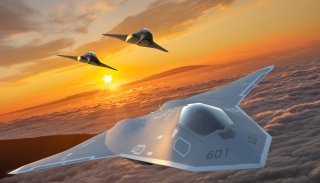NGAD: This $300 Million Stealth Fighter Is Worth Every Penny
Even at that high a price, this fighter may still be a serious bargain.
So, even if production had simply paused, rather than halted and we could somehow restart F-22 production today exactly as it left off, new Raptors would still be creeping up on the $300-million-per-airframe mark, especially if systems that were left out of the original Raptor but are now considered necessary, like infrared search and track or helmet-cued targeting, were incorporated into the design to bring it on par with its more modern competition.
Related: America’s F-22 will see serious upgrades before retirement
THE F-35’S ORIGINAL PER-UNIT COST WOULD BE MORE THAN $330 MILLION TODAY
As we discussed earlier, the F-35 Lighting II borne out of the vastly expensive Joint Strike Fighter program has been getting consistently cheaper over the years thanks to a laundry list of customers and high production volume. However, that wasn’t always the case.
Back when the F-35 began its production run in 2007, it was quite a bit more expensive… at approximately $221.1 million per airframe. When adjusted to 2023’s inflation, that comes out to approximately $331.5 million per fighter today.
However, it’s important to note that the F-35’s per-unit cost dropped dramatically in its first years of production, with Low Rate Initial Production (LRIP) Lot 2 following that same year at just $161.7 million per aircraft, which shakes out to about $242.3 million per fighter. And by 2012, it had dropped all the way to $107 million per jet, or about $143 million today.
Related: What kind of fighter could the latest military tech really build?
ADJUSTED FOR 2023’S INFLATION, MAVERICK’S F-14 TOMCAT COST $270 MILLION EACH
Air dominance has always been expensive. Nowhere is that more clear than in the Navy’s legendary F-14A Tomcat made famous in 1988’s Top Gun.
In 1973, the U.S. Navy was purchasing these Tomcats at approximately 38 million each, which as compared to the numbers we’ve been throwing around thus far in this article, seems like a downright bargain. But inflation can be tricky, and many have forgotten in the years since the fall of the Soviet Union that the United States was sometimes devoting as much as a whopping 10% of its gross domestic product (GDP) to defense during the Cold War.
For context there, America’s massive 2022 top-line defense budget of $857.9 billion represents a reported 3% of its GDP. If the U.S. were still spending at the rate it did during points of both the Cold War and Vietnam, today’s defense budgets would be closer to $2.5 trillion.
The Tomcat is a perfect example of just how much the U.S. was willing to spend on defense. Adjusted to today’s inflation, each F-14A would ring in at an astonishing $270 million.
AIR DOMINANCE AIN’T CHEAP
We may not know much about America’s next air superiority fighter being developed within the Next Generation Air Dominance program, but one thing we know for sure is… that it won’t be cheap. The United States has long led the world in airpower. From being the first country to field military aircraft; the first to arm aircraft; the first to conduct mid-air refueling; fly bombers around the world; build stealth attack planes, fighters, bombers, and more, America has long been willing to invest in the ability to take the fight to its opponents from the sky, and to do so with such overwhelming power, capability, and volume to dominate the airspace over any fight it’s in.
This approach to warfare is more than a habit, it’s baked into nearly every facet of America’s warfighting doctrine. America’s approach to war splits a conflict into six phases: shaping, deterring, seizing the initiative, dominating, stabilizing, enabling civilian authority, and then a return to shaping.
As Dr. Rebecca Grant, president of IRIS Independent Research, pointed out in Air Force Magazine some 13 years ago, airpower plays a role in each and every phase — and is absolutely vital for a handful of them.
The fact of the matter is, the United States’ way of war doesn’t include dominating the skies… it mandates it. And as we’ve seen from the 1970s straight through to today… dominating the skies is an expensive endeavor.
So, if we do come to learn that the NGAD fighter does indeed cost around $300 million per fighter, we should see that not as an immense leap in price over the jets that came before it, but rather as the going rate for air supremacy.
Alex Hollings is a writer, dad, and Marine veteran.
This article was first published by Sandboxx News.
Image: Mike Mareen / Shutterstock.com

